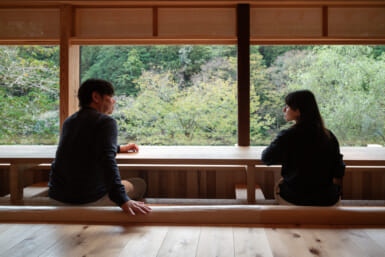The other day the news assistant here went out for a walk in the Roppongi 1-chome neighborhood—stretching her 84-year-old limbs—and she came back with a glowing report.
“Hey, the plaza at Ark Hills is a mass of red… they are making a big thing of Christmas this year— last year it wasn’t appropriate coming just after the Twin Towers, I suppose,” she said. “But this year they have really gone to town with a deep, dark, rich red. This year is different in feeling. Go and have a look.”
I set off for the Karajan Plaza, taking the morning mail with me to send off to England and, sure enough, the plaza is on fire this year with the most cheerful decorations in a generation. I’ve seen them all since Ark Hills opened up in 1985, and I can state that this year surpasses all of ’em in terms of color.
Talk about staving off a recession mood… A tremendous battle for survival is being waged before our eyes. With stock prices plunging and major banks preparing to bow down their heads, to ask the government for help, what will happen on the real estate front here? Who will prevail, as push comes to shove?
The bankers I listen to on the subject—a lot of new office space opens up next year in Tokyo—are of the opinion that the likely winner is Mori Building. “It’s got that site up on the hill, that makes it exciting,” said one friend from the UK, visiting from London last month. He referred to Roppongi Hills, and the new development that Mori will open there in the spring. This is to be the subject of a big Mori press conference scheduled for Thursday, Dec. 5.
Who are the other principal contenders in the real estate stakes? Foremost among them is Mitsubishi Estate. Not long ago a group of us visited the new “Maru Biru” or Marunouchi Building— the prime chunk of property opened up of late by Mitsubishi Estate, just outside Tokyo Station, beautifully positioned to catch day-visitors from the Kansai, getting off the Bullet Train. From that point of view Maru Biru is a dead cert winner, as are the other Mitsubishi buildings going up around there in Marunouchi— there are half a dozen of them, as you can see by counting the cranes aloft in the sky down there.
The only trouble, I would say, is that Marunouchi is boring. It is flat and dull and so, frankly, are the people. When our group visited Maru Biru the other day—it was Sept. 17, to be precise—we were received by Shigeru Takagi, president of Mitsubishi Estate. He gave us a few words of wisdom, saying, among other things, that “the new buildings going up in Tokyo will all pretty much fill with tenants.” With these well-chosen words, he indicated the optimism that is in the air, as far as the real estate kings are concerned.
Altogether, we spent two-and-a-half hours in the building. I was impressed by the huge tree trunks that have been let into the floor there, so that you can see them through transparent panels.
The old Maru Biru, we were told by our escorts from Mitsubishi Estate, was founded upon hundreds and hundreds of these giant tree trunks. In digging the foundations for the new building Mitsubishi had to unearth those enormous wooden boles. It’s great that they have preserved a couple of them for posterity, where one can see them.
But overall the Marunouchi section is unexciting, I find. We are all supposed to marvel at Naka Dori—the Inner Street, going all the way from Yurakucho up to the old IBJ head office in Otemachi, a straight mile almost. But the overall impression is of a lack of zizz. I didn’t feel that this was a contender with, say, Omote Sando.
There’s something lacking in the people. At the end of our guided tour the other day—there were a dozen of us, all foreign correspondents—I sensed a slight disappointment among the colleagues. None of us was offered so much as a glass of water, at the end of our 150-minute peregrinations within stately Maru Biru.
“God these Mitsubishi chaps are so kechi,” a Korean correspondent muttered. Kechi means “stingy” in Japanese and it means Scrooge-like.
All eyes then are on the rival show. This is, as mentioned, at Roppongi Hills, and it is the biggest effort to date by Mori Building Co. and its upbeat shacho, Minoru Mori.
I have not seen him to talk to for about six months, but the last time I did encounter him at his exclusive Ark Hills Club—up on the 37th floor of the ARK Mori Building—he took me by the elbow, and pointed to two new Mori buildings half a mile away across the city at Atagoyama, one for offices, one residential.
“Look at them,” said Minoru-san in excitement.
He is Tokyo’s counterpart to “the Donald,” meaning Donald Trump of New York, so Business Week wrote the other day, noting that Mori Building has borrowed some $6 billion to fund its new developments—not so much in light of the size of the projects, many of them in Roppongi, such as a new tower at Moto Azabu, just opposite Nishimachi School, that I visited the other day.
So let’s wait and see what happens at Roppongi Hills—easily the biggest urban development project in the history of Tokyo—when it all opens up in the spring, with a Hyatt Hotel, with the Asahi TV broadcasting center and with the Mori Art Museum opening up on the top floors of the main building, up above the 50th story. I think it’s going to be spectacular, in terms of impressing the tenants, bringing them in and sending a message to the world that Tokyo is going international.
My guess is that Mr. Mori will break out the bubbly, when the moment comes to unveil his Roppongi Hills. When will that be, by the way? Ah, sometime in April 2003 or thereabouts. At that point, the host will throw a party. There will be a Jeroboam or two, I would imagine.
I would like to toast the guy who built the “Rocky Center” of Tokyo. Roppongi Hills should be as much a focus of energy in Tokyo as Rockefeller Center in New York in the 1930s.
Banzai!









